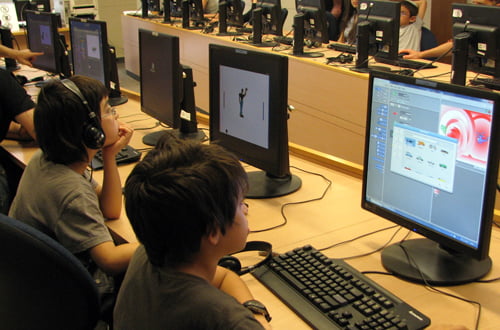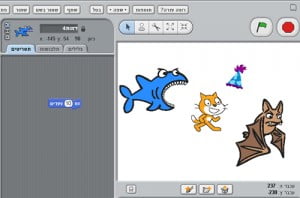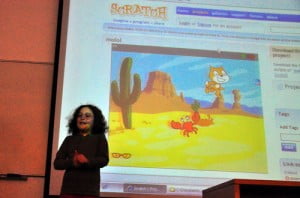If you ask some of the world’s leading tech figures when they learned the bulk of their computing and programming experience, they’d probably point back to their teenage years, at the latest. Children today are ever more tech savvy, surrounded by an assortment of screens, tiny and large.
The Scratch program, developed at Massachusetts Institute of technology (MIT), is dedicated to this purpose exactly: to teach young students programming concepts and develop skills in multimedia communication.
Related Stories:
Scratch was created as a free programming environment that makes it easy to create interactive stories, animations, games, music and art. It is also a means for children to express themselves in an open platform that allows them to immediately share their works with others.
[vimeo]http://vimeo.com/4077929[/vimeo]
Dr. Oren Zuckerman, of the Interdisciplinary Center in Herzliya (IDC) and previously part of the MIT Media Lab team, and Noa Morag, launched the Israeli Scratch program at IDC’s miLAB – the interactive media innovation lab at the School of Communications. Morag tells NoCamels Scratch is meant to empower children and show them they can be an active part of the content they consume online.
How to scratch
The Scratch website, available in 50 different languages, is in some sense similar to a Facebook page: users have a profile, they can add friends, see others’ projects, comment on them and subscribe to someone or to a gallery of projects. To take part in a project, users need to register, download the software and then upload it online once they have finished working on it.
When opening the Scratch program, a workspace appears with different shortcut buttons on the side. Let’s say you have a picture of a woman gardening in her yard. With one click you can change the color scheme, what she wears, add music, replace the woman with another figure from a different picture or change the scenery completely. You can even add motion to the static image and see the woman actually planting. Additionally, you can add an active area on the picture, and by clicking there you get to another scene. That turns your work into an interactive story, whereby clicking on different areas of the picture trigger different events.
The projects developed by the children include animations, music, music videos, games, drawings and interactive stories. “As young people create and share Scratch projects, they learn important mathematical and computational ideas, while also learning to think creatively, reason systematically and work collaboratively,” Morag tells NoCamels.
Scratch primarily targets users aged ten to 12 years, although it is apparently most popular with older teenagers.
Morag says that Scratch shows that “everything is do-able, there are no limitations and there are many ways to do things. Every new way teaches you something different. It’s like giving you the hook but not the fish: you can do whatever you want, but there are still guidelines.”
Sign up for our free weekly newsletter
SubscribeScratch provides children with a large library of media, but also allows importing from Youtube, Google Images, or any material found on the internet.
Mentoring the children
The Israeli Scratch provides mentors for the children, who meet in groups biweekly. Last year, 30 college students where trained as mentors, to reach out to the community in nearby schools in the center of Israel, Druze towns in the north of the country, or in the desert town of Beer Sheva in the south.
Morag explains that “you don’t have to know everything to be a mentor. This way you actually work better with the children, because you’re also experimenting, and this is what Scratch is about.”
The mentors were divided into teams based on different responsibilities such as offline mentoring, social media coordinators, online community outreach, developing teaching aids for educators and parents and assisting in research. The project is fully managed by volunteers, with the purpose of spreading Scratch as a programming tool for children – but first and foremost to demonstrate innovative thinking.
The aim is not to intimidate the children, but to make them believe that they can do it, Morag explains. “For example, instead of creating a whole new game by yourself, you can download someone else’s game – or some programs already in the system – and you can ‘remix’ it by changing the design, the motions, anything.”
Expressing yourself
In addition to being a learning sphere, Scratch also allows children to express themselves. “In one of the schools we went to, there was this young girl who had some trouble with her parents,” Morag says. “The teacher encouraged her to use the program, and she did – and you could see that what she created was personal and that she was really trying to get something out there.”
“Another time there was this young boy who was very protective of his stuff, as many fourth graders are. He didn’t like to share. But during the workshop, all of a sudden, he became the teacher of all the kids around him and you could see a happy relationship between him and those he was teaching.”
Every May, Scratch holds an annual “Scratch day” event at IDC Herzliya, where Scratch is introduced to teachers, students and children. The project has already been used by 600 children and dozens of teachers.
Related posts

Rehabilitation Nation: Israeli Innovation On Road To Healing

Israeli High-Tech Sector 'Still Good' Despite Year Of War









Facebook comments